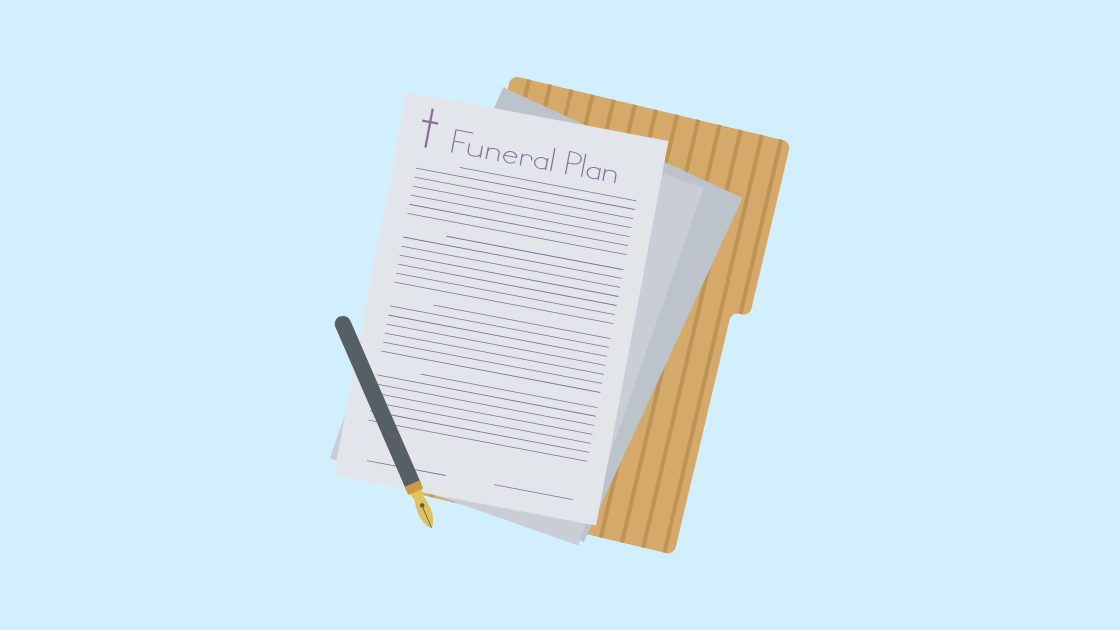Asking how much does a funeral cost is an important aspect of preplanning. Funeral expense for the funeral home to ready the body for a viewing and burial can cost nearly $8,000 vs. $7,000 for cremation with a viewing - plus costs to bury or display the body or remains.
When it’s time to die, the process is costly. The actual cost depends on the cost of your end-of-life care, the state where you die, and where and how you want to be buried or finally attended to.
In the ideal world, most people would prefer to expire on their own terms, at a time they planned for, without elongated pain and suffering. Death doesn’t follow anyone’s plan, so all the living can do is make final preparations armed with knowledge and life insurance policies or savings!
Here are some questions to ask as you think about the eventuality of your own passing. If cost is an issue, alternative ways of caring for disposing of the body and different types of funerals might be worth consideration.

Table of Contents
What Is The Cost Of A Traditional Funeral Vs. Cremation?
The National Funeral Directors Association published 2022 stats that establish the average cost of a traditional funeral with a viewing at the funeral home at $7,848 vs. $6,960 for cremation with a viewing.
When the family wants a viewing or wake, embalming the body is standard practice at funeral homes to retard decomposition until after the funeral service. Funeral directors may offer a package of services that includes administrative time, preparation of the body, a casket, transportation in hearses, staffing, and more.
Upgraded caskets, extra viewings, luncheons at the funeral home, flowers, and even obtaining death certificates are additional charges. The cost of a casket, for example, can be thousands more for high-end woods, costly metals, and embellishment.
The Federal Trade Commission developed the Funeral Rule in 1984, which requires that funeral service providers be transparent with their charges so consumers can make informed decisions about what they need. The law does not make funeral pricing any lower.
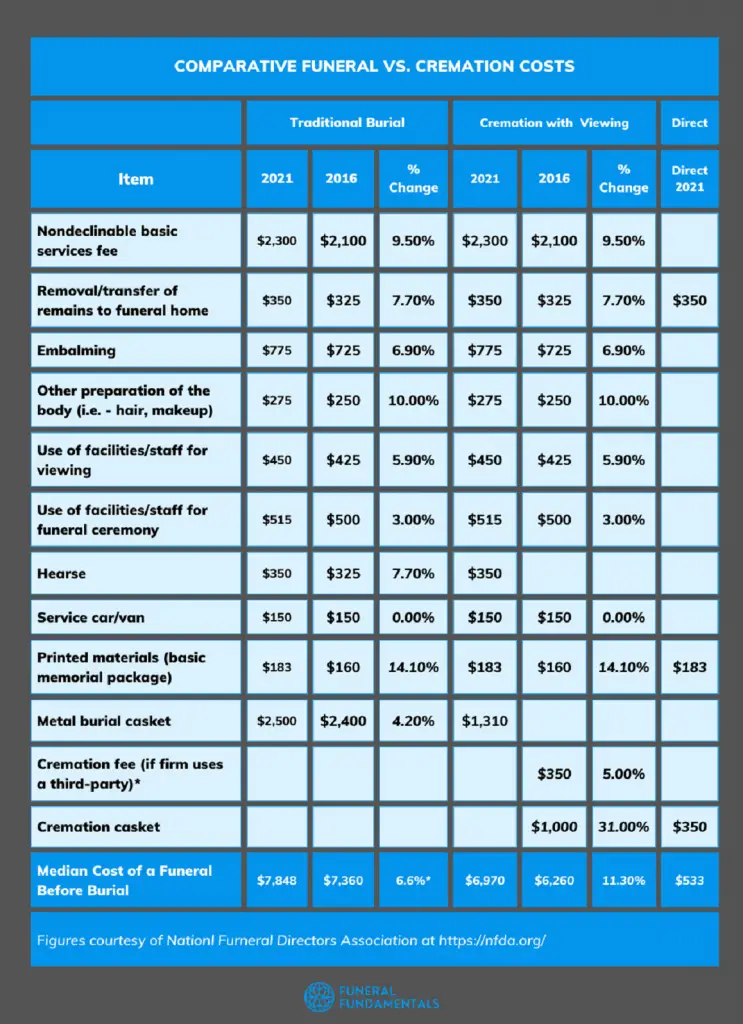
How Do Traditional Funeral Costs Compare To Cremation?
The most significant savings with cremation come with direct cremation with no viewing. As is true in all areas of the funeral business, the more services you want, the higher the cost. For those who want a private viewing, a memorial service at the funeral home, or services and visitation before noon, the costs are adjusted up or down.
When those who will be cremated have a larger public viewing, the funeral home can provide a rental casket that is replaced with a wood or cardboard vessel for the processing or can place the deceased in a suitable cremation casket made of wicker, wood, or cardboard. Using the same container used for later cremation will bring the costs down a few hundred dollars.

What Costs Are Associated With Burial?
The costs included in NFDA estimates do not include flowers, obituaries, receptions, documents, or the cost of funeral or cremation services at a church, synagogue, or other facility or at the graveside. They also do not consider the costs associated with burial – a burial plot, outer burial containers such as a burial vault or grave liner, cemetery costs to open and close the grave, or a headstone or grave marker.
Whether you want to bury a body or cremated remains, the cemetery will charge for the burial plot, vault or grave liner, opening and closing fees, and markers or headstones. Bypassing traditional burial is pricey too.
The costs vary, but buying a single plot can add as much as $12,000 to the price of a funeral or cremation. For a family that selects entombment in a mausoleum or lawn crypt or entrusts cremation remains to a columbarium, cremation garden, or benches, the costs add thousand to the burial as well.
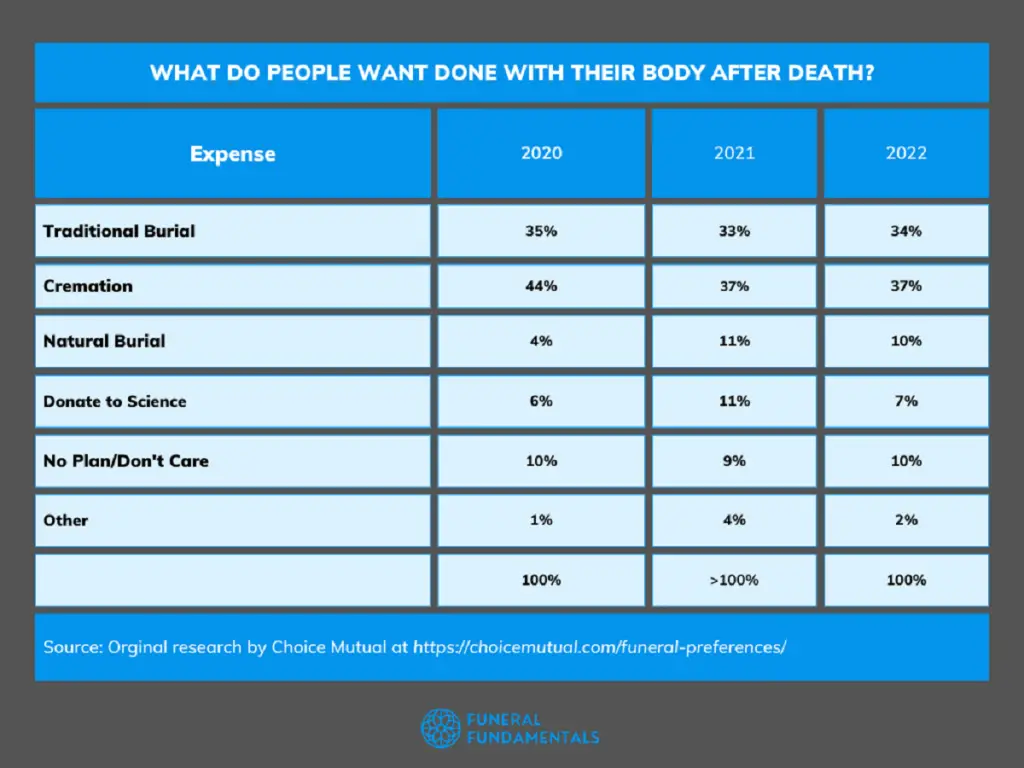
Can I Save If I Want A Green Or Natural Burial?
To above spending thousands, taking up land, and using and expelling toxic chemicals into the environment, many select green or natural burial options.
Embalming requires the use of formaldehyde, a chemical that can leach into the ground and infiltrate the water supply. With a natural burial, the body is wrapped in a shroud and placed in the ground without a casket, vault, or grave liner. The headstone that marks the grave is a simple stone from nature, enhanced with a bronze plaque. Flowers and other plants may grow over the grave.
Green burial follows the processes of natural burial but inters the remains in a cemetery certified for its observance of green principles.
Some people prefer to hold a home funeral and bury the loved one on private property. Depending on state law, they may need minimal involvement from a funeral home to file documents, but they follow natural burial procedures, so the body need not be embalmed, have a viewing in a funeral home, or have expensive burial plots.
All states except California, Indiana, and Washington allow home burials, while only Alabama, Connecticut, Illinois, Iowa, Louisiana, Michigan, New Jersey, New York, and Nebraska require some involvement with a funeral director. Many people choose to use a funeral director for some parts of the home funeral process – a practice known as a hybrid funeral.
In the remaining states, those who hold home funerals are exempt from some standards funeral homes must adhere to regarding refrigeration or embalming of the body. If they hold the body for more than a day, they cool it with dry ice to retard odor and decay.
More people are considering natural burials these days.
Chart https://choicemutual.com/funeral-preferences/
To find out the rules about home funerals in each state, visit the National Home Funeral Alliance website.
For more information about green burial, visit the Green Burial Council.
End-Of-Life Expenses Add To The Cost Of Death
While some people die unexpectedly in their sleep from heart problems, strokes, sleep apnea, carbon monoxide poisoning, and other disorders, many have terminal illnesses or conditions that lead to hospitalization. While health insurance may cover many expenses, families are usually left with thousands of dollars in out-of-pocket costs not covered by insurance.
While these costs are not part of funeral cost calculations, they come due just as the family is grappling with how to pay for the funeral.
These average end-of-life costs also vary by state.
These medical expenses are in addition to any legal procedures to settle the deceased’s affairs, estate taxes,
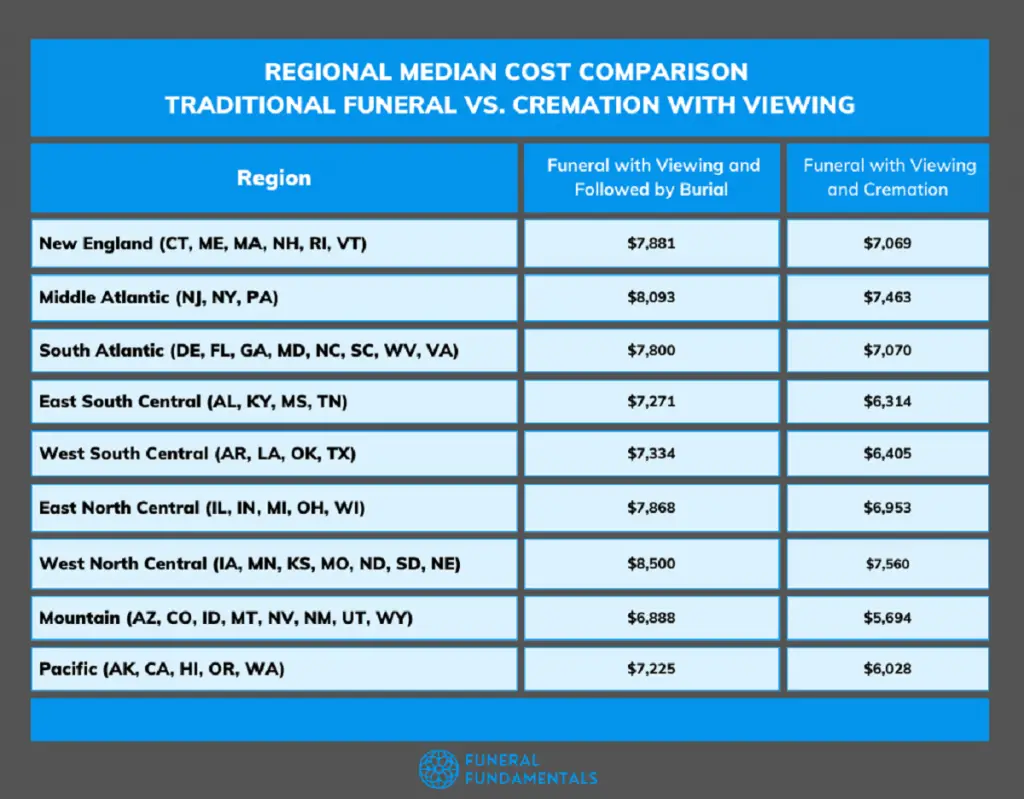
How Much Does A Funeral Cost In My Region Of The Country?
The NFDA offers a handy regional breakdown of cost. The least expensive funerals tend to be in the East South Central state of Alabama, Kentucky, Mississippi, and Tennessee, while the most costly are in the West North Central states of Iowa, Minnesota, Kansas, Missouri, North Dakota, South Dakota, and Nebraska.
The most expensive cremations take place in the West North Central states, while the least expensive ones are in the mountain states of Arizona, Colorado, Idaho, Montana, New Mexico, Utah, and Wyoming.
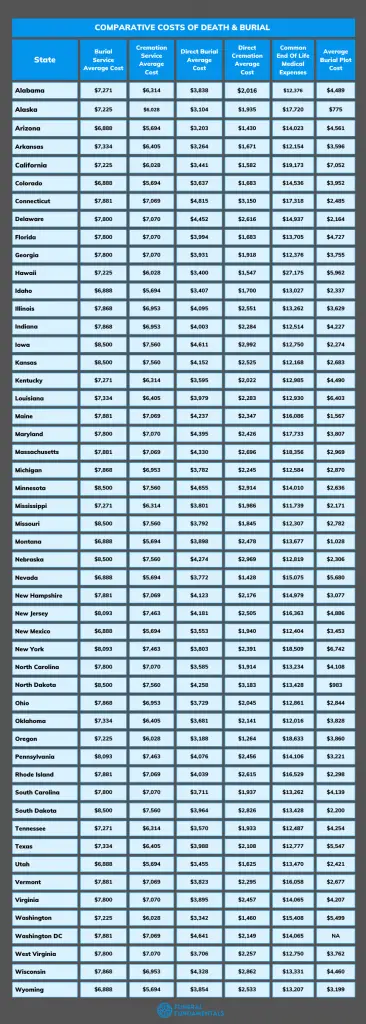
How Does This Compare To The Costs In My State?
In addition to the costs of a funeral with a viewing followed by burial or cremation or direct burial or cremation, there are additional costs of a burial plot and other cemetery fees. For most people, the expense involved in the last months of their life might be quite high. If they were hospitalized, especially in the Intensive Care Unit, or need home care services, the costs might be many times what is listed.
The chart shows the basic costs – and still does not include flowers, obituaries, fees to the church or clergy, funeral reception costs, and other incidentals.
The NFDA calculated the comparative median costs of a traditional funeral and burial with those of a cremation followed by burial in the ground. The figures are exclusive of burial plots, cemetery costs, and incidentals.
What Happens If I Die Away From Home In Another State Or Country?
If you die away from home, your family must make some decisions to get your remains home for a reasonable cost and in compliance with state and local laws. If the deceased passed away in a foreign county, the red tape and costs involved can be staggering – and underscore the advantages of buying trip insurance that includes the return of the body to loved ones at home.
In National Lampoon’s Vacation, Chevy Chase and his family had Aunt Edna with them for part of the trip. When she died, they tied her on top of the car with the luggage and dropped her off at the home of a relative who wasn’t even home. In real life, the transport of a dead body is not that simple. and hopefully, not so heartless.
Most states have laws governing the transport of dead bodies. As Jim Bates of the Funeral Consumers Alliance of North Texas points out, at the very least, the family needs to obtain a burial transit permit before driving a body home for burial. While you might make it home undetected, you would be in big trouble if you stopped.
There are things to be done before moving the body. For example, someone needs to come forth with your authorization of disposition, which states your wishes for burial or cremation.
The attending physician or medical examiner may need to become involved, especially if the deceased may have had a communicable disease. If so, a higher level of precaution may be indicated in dealing with or shipping your body home.
Shipping a human body is costly, due to the weight and need for safety. Most jurisdictions have laws that govern:
- How long a body can remain un-embalmed or unrefrigerated
- How long can it be refrigerated
- How can it be shipped
- Transporting a body across state lines often requires embalming and shipment in a sealed, airtight container
If the deceased is to be cremated, there may be a mandatory waiting period before that can be done. The costs for direct cremation, followed by shipment of the remains, are far less than shipping a body.
See Shipping A Dead Body: How To Transport The Deceased for details.

Paying For Funerals
When the costs of funeral home care, funerals and memorial services, burial or other disposition, and miscellaneous expenses are merged with end-of-life expenses, the amount involved leaves many families worried about how to pay for it.
Ideally, the deceased will have savings or insurance to pay for the funeral.
Those who plan on paying their funeral expenses in cash with money from their checking or savings accounts should have them set up to be payable on death (POD) so that the family or executor of the estate can access the money without it going through probate. Banks in some states allow the executor to take out up to $10,000 to cover funeral expenses, but not all banks honor the withdrawals. Some states even put a hold on half of joint accounts, and funds can be held up for years.
Having funeral insurance, whole life insurance policies, or term life insurance to cover the costs is a better idea that allows the money to be released to the policy beneficiary without passing through probate. Buying a preneed policy set up with the funeral home or having the funeral director listed as an insurance beneficiary also ensures timely payment to the funeral home.
A friend or relative might put the charges on a credit card or work out some payment arrangements with the funeral home to cover funeral costs, or wait until the life insurance company pays out. But there are other options that might be used to piece together the payment.
Families can set up a Go Fund Me account that might provide enough to pay for the funeral. Family, friends, and even strangers may donate to the funeral fund at a time when even a few dollars help.
Neither Medicare nor Medicaid pays funeral costs. There are, however, some government-sponsored programs that might offer some help to families struggling with the financial burden of a funeral. These include:
- Social Security offers a small death benefit of $255, payable to some spouses and children.
- The Veterans Administration offers $300 toward funeral expenses of veterans who died of non-service-related expenses and up to $2,000 for those whose deaths were service related. The VA also offers free or low-cost space in veterans cemeteries throughout the country.
- Those who died in a natural disaster might get help from FEMA, the Federal Emergency Management Agency
- The families of victims of crimes might be able to get between $10,000 and $100,000 from the National Center for Victims of Crime fund.

